












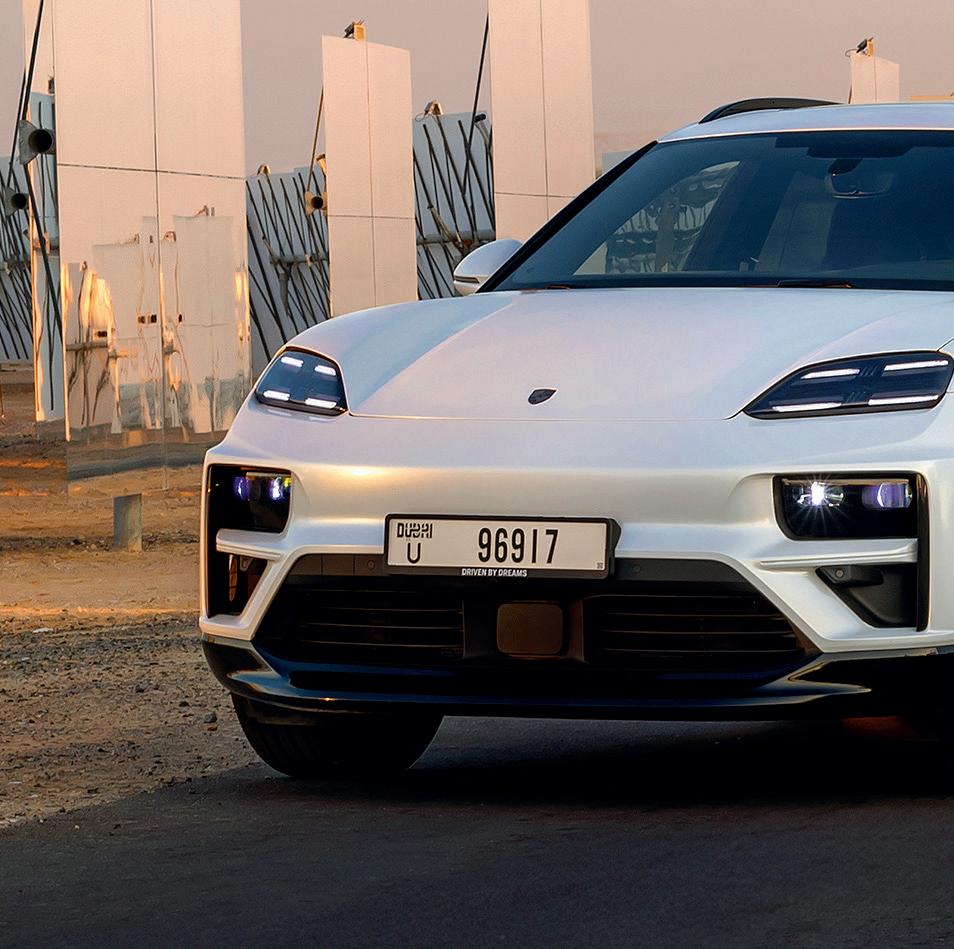
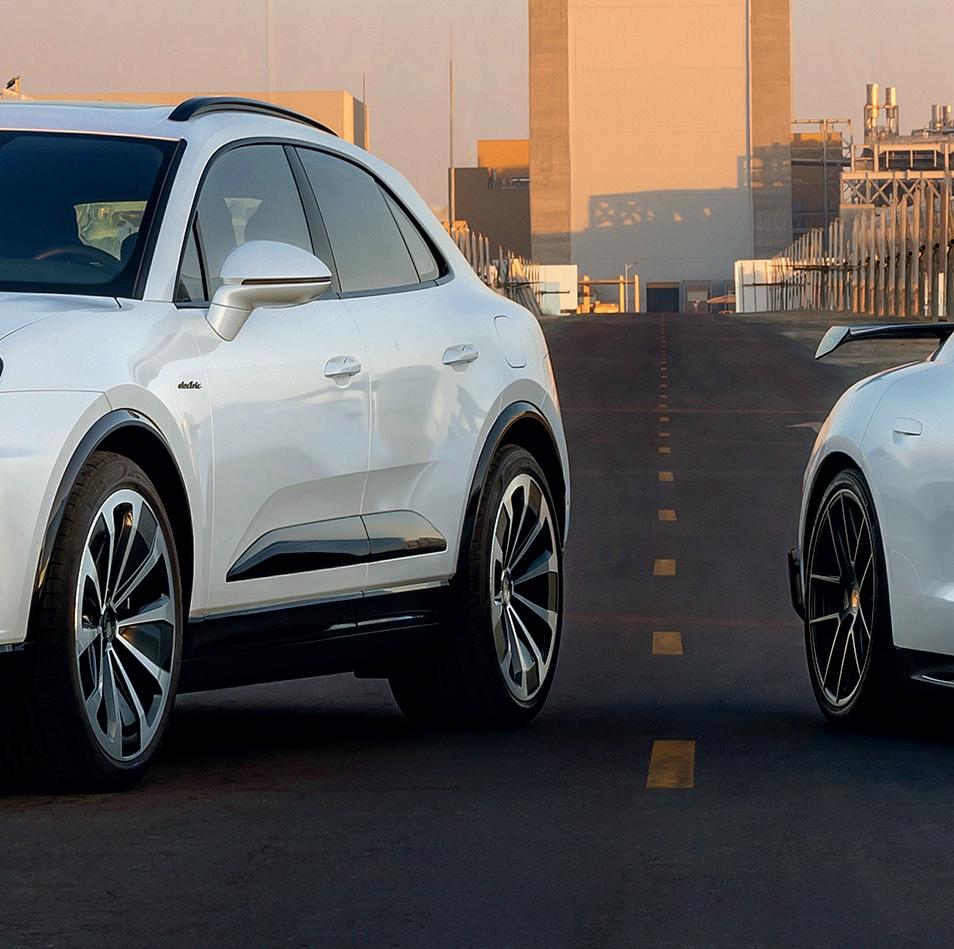








































a country of contrasts, coastlines, and a single Porsche.
Text: Kathleen Van Bremdt - Photos: Sven Hoyaux & Graatje Weber - Video: Eyecandy

ozambique is a country that surprises with breathtaking coastlines, national parks teeming with wildlife, vibrant cities, and villages infused with a touch of Portuguese heritage. It’s here that we meet Hussein Ibny Ali Hassan, the only Porsche owner in the country.
Our journey to Mozambique proves that it can. A year ago, while browsing eBay for something completely unrelated, we stumbled upon a 2013 stamp issued by Mozambique to commemorate the 50th anniversary of the Porsche 911. The image showed two black 911s. Our curiosity was piqued. Mozambique… we knew little about it. Where exactly is it? What makes it unique? Would a visit yield material for a story? And most importantly: are there even Porsches on the road there? The stamp suggested so, but that was far from a guarantee. In the following weeks, we pieced together a travel itinerary and, after a lengthy search, managed to track down a Mozambican Porsche owner. What began as a chance discovery of an illustration on a small piece of paper led to an exotic journey to a distant corner of the African continent.

A few weeks before our departure, Mozambique suddenly hits the news. Tensions are rising. The reason: the controversial outcome of the presidential election held on October 9, 2024. According to official results, the ruling party Frelimo – in power since 1975 – secured 70% of the vote, while the opposition party Podemos gathered only 24%. But opposition leader Venancio Mondlane and his party refused to accept the results, accusing their opponents of large-scale fraud. International observers, including the European Union and the United States, confirmed irregularities. Mondlane’s supporters took to the streets en masse to voice their discontent. The authorities responded with force, and what began as peaceful protests escalated into violent clashes within days. We followed the news closely. The unrest dragged on for weeks, peaking on December 23, 2024, when the Constitutional Council ratified Daniel Chapo's election victory. His inauguration was scheduled for January 15. The volatile situation left us with a dilemma. Our departure date was January 13. Could we still go, or was it too dangerous? We decided to take the chance. After all, fortune favors the bold, right?



Mozambique lies in the far southeast of Africa and boasts nearly 3,000 kilometers of coastline along the Indian Ocean. Its neighbors, from south to north, are South Africa, Botswana, Zimbabwe, Malawi, and Tanzania. With a land area of just over 800,000 km², Mozambique is about 26 times the size of Belgium and home to around 36 million people. We flew with Ethiopian Airlines – always a solid choice for flights to the African continent. Upon arrival at the airport in Maputo, Simba, our local guide, was already waiting for us. He helpfully escorted us to a waiting car. He and the driver would accompany us for the next few days. “How dangerous is it here at the moment?” we asked right away. “Don’t worry,” Simba replied, “it is safe at this time of the day.” At this time of the day… we wondered silently how things were at other times. We saw many military vehicles and police along the roads. It was obvious something was going on in the country, but we saw no protests and reached our hotel without any problems.

And what a hotel it was. The Polana Serena Hotel – often referred to as the “Grande Dame” – is one of the most iconic and prestigious hotels in Africa. Located on Maputo Bay in the upscale embassy district, the hotel offers an impressive view of the Indian Ocean, while being just minutes from the city center. Designed by British architect Sir Herbert Baker, it opened its doors in 1922. The grand colonial building still exudes the charming grandeur of a bygone era, blending classic elegance with modern luxury. Nelson Rodrigues, the hotel’s General Manager, greets us warmly. “Welcome to the most secure hotel in Africa right now,” he says with a broad smile. As it turns out, thirteen heads of state and their entourages – bodyguards, advisors, generals – are staying at the hotel over the coming days. These dignitaries are invited to attend the inauguration of the new president on January 15. The hotel has 132 rooms and 10 suites, all furnished in classic style with dark wooden furniture, chandeliers, and comfortable sofas. Our room is on the third floor, nestled between the delegations from Angola, Guinea-Bissau, India, and Chad. Our casual outfits stands out among all the men in neatly tailored suits and uniforms. We are two odd ducks, and that gives us a special feeling – a kind of accredited outsider status we gratefully embrace. In the bar, we strike up a conversation with Ahmed Kassam, an advisor to the president of Chad. He listens intently as we explain our purpose in Mozambique. “Add Chad, Sierra Leone, and Zanzibar to your to-do list,” he says enthusiastically. “Sure,” we reply, “but we need a Porsche driver in each country.” “How many do you want?” the man says with a broad grin. “I’ve got contacts everywhere – I’ll sort it out.” We take his words with a grain of salt, but still jot down his contact details. You never know. If a travel story can start with a postage stamp, it might just as well start with a bit of small talk.


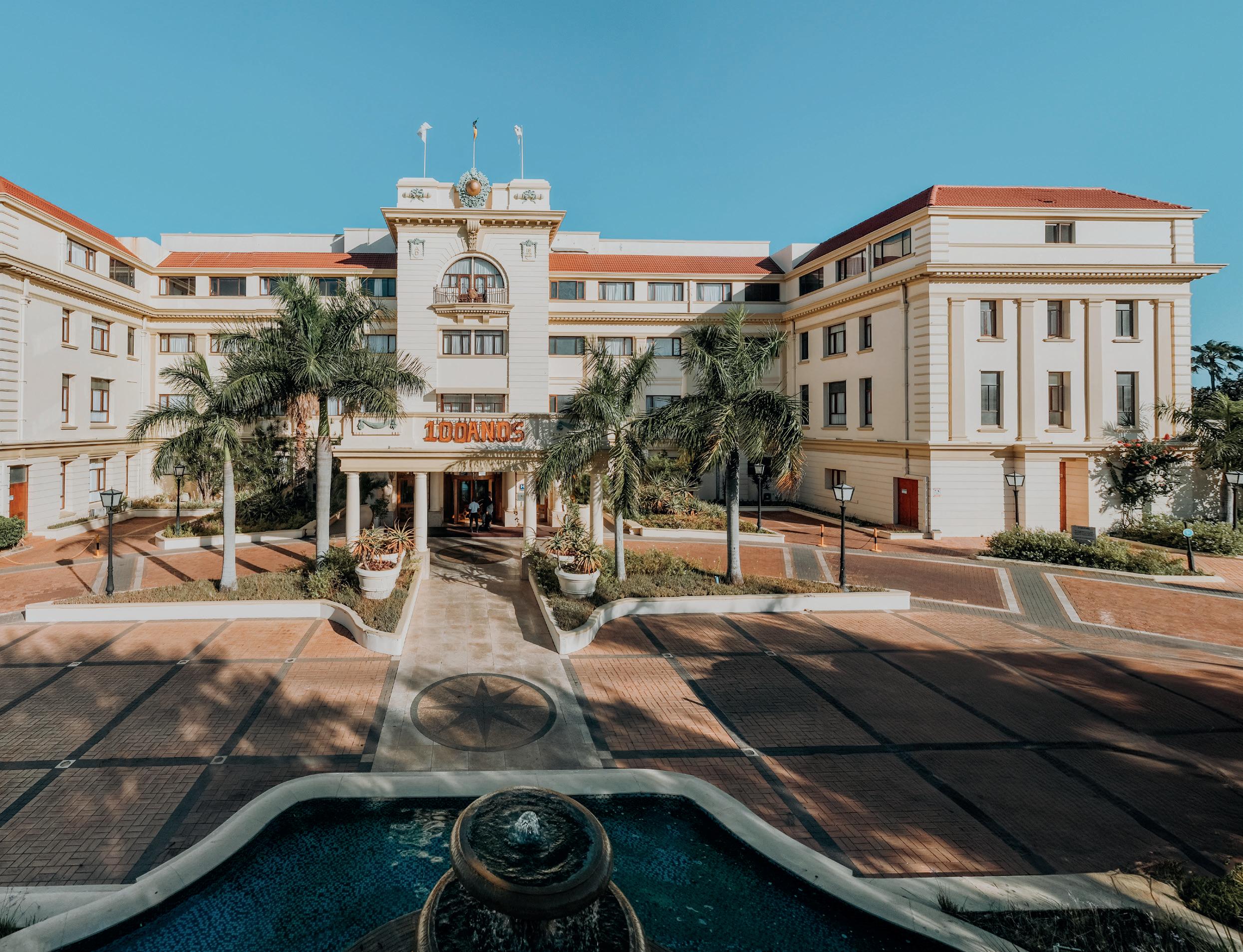
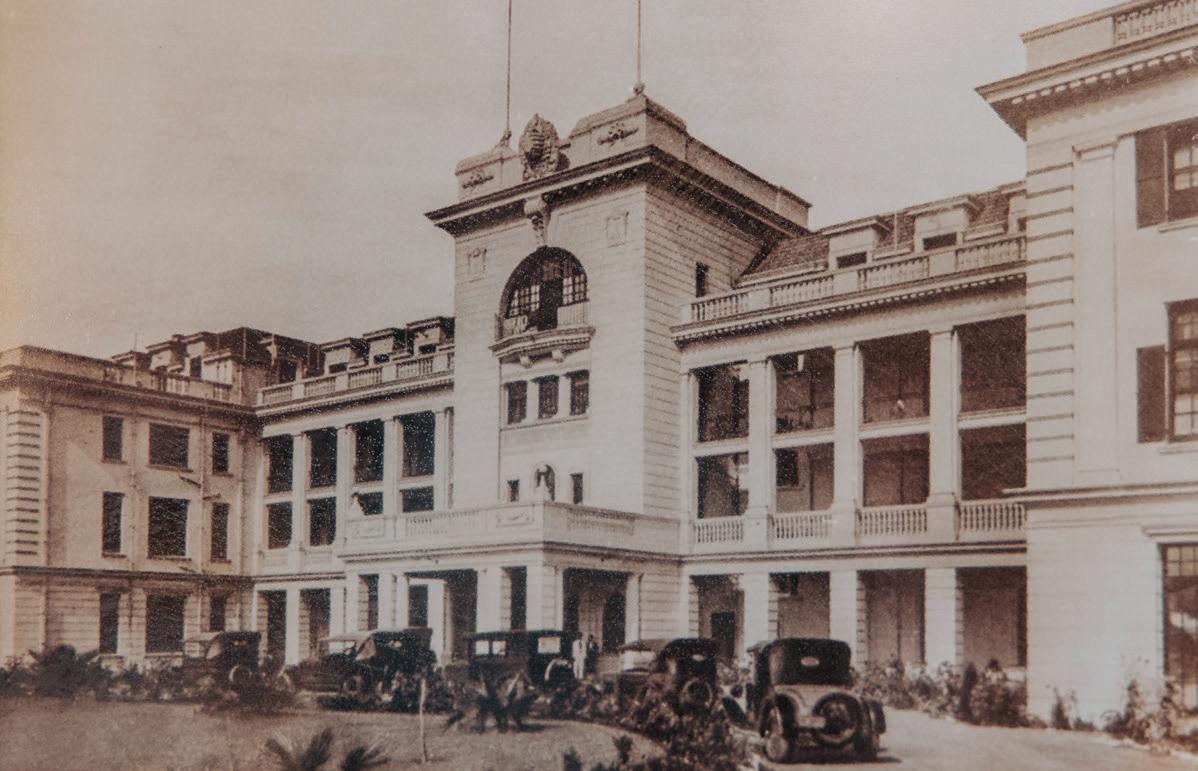
The Polana Serena Hotel in Maputo - often referred to as the ‘Grande Dame’ - is one of Africa's most iconic and prestigious hotels.



WEDNESDAY, JANUARY 15:
Today, Daniel Chapo is to be sworn in, and there’s a palpable tension in the air. How will the day and the inauguration unfold? What is the opposition planning? Will they try to boycott the ceremony? Could things erupt into unrest or even violent confrontations? Authorities are taking every measure to keep opposition supporters at bay. All roads leading to the presidential palace and the Praça da Independência – the square where the new president will take his oath – are sealed off by police and military units. Armored vehicles roam the city, blocking intersections. We try to get close to catch a glimpse of the proceedings, but are quickly stopped by soldiers armed with Kalashnikovs. It’s a strange feeling. In a city that normally buzzes with energy, there is now an eerie, threatening silence. Shops are closed, streets are empty, the center deserted. No one dares venture outside.
We manage to slip into the Cathedral of Nossa Senhora da Conceição through a side entrance, which sits right next to the square. Inside, a group of choirboys is rehearsing. We quickly snap a few photos of the impressive altar but hurry outside when we see two soldiers approaching. That evening, we watch the news and learn that around 2,500 guests attended the inauguration and, against all expectations, no significant incidents occurred. With Chapo now officially in office, many hope the country will finally return to peace after three months of unrest.




Political unrest is nothing new for Mozambique. The country has a long and tumultuous past. Centuries ago, it was already an important trading hub for Arab and Persian merchants dealing in gold, ivory, and slaves. In the 16th century, the Portuguese arrived, and their rule would last nearly five centuries. Their influence is still visible today—in the language, cuisine, colonial architecture, and Catholic churches that rise even in the smallest villages. Mozambique only gained independence in 1975, after a long and bloody struggle. But true peace came much later. First came a devastating civil war (1977–1992) that left its mark on the country for decades. Today, Mozambique shows remarkable resilience. The scars of the past remain, but the prospects for a better future are promising.


We meet Hussein Ibny Ali Hassan, our Mozambican Porsche driver. He arrives in a deep-blue Cayenne, the epitome of elegance among the diplomatic vehicles and tinted-window SUVs in the hotel parking lot. We immediately head out to photograph the Porsche at beautiful locations. The front of the grand Serena Hotel is a great starting point. In the city center, we find a small alleyway where colorful graffiti brightens the walls. A few women walk by. Dressed in vibrant fabrics, they look picture-perfect. Like almost all women in Mozambique, they wear a capulana, a rectangular cloth wrapped around the waist like a skirt, paired with a matching headscarf. With lots of laughter and chatter, they happily pose for the camera. There’s no laugh quite as infectious as that of African women—warm, genuine, and delightfully unrestrained. The girls are having a great time. Two police officers come over to check things out, and once they realize a photoshoot is taking place, they eagerly join the women for a picture.


No laugh as infectious as African women's: generous, artless and delightfully uninhibited.
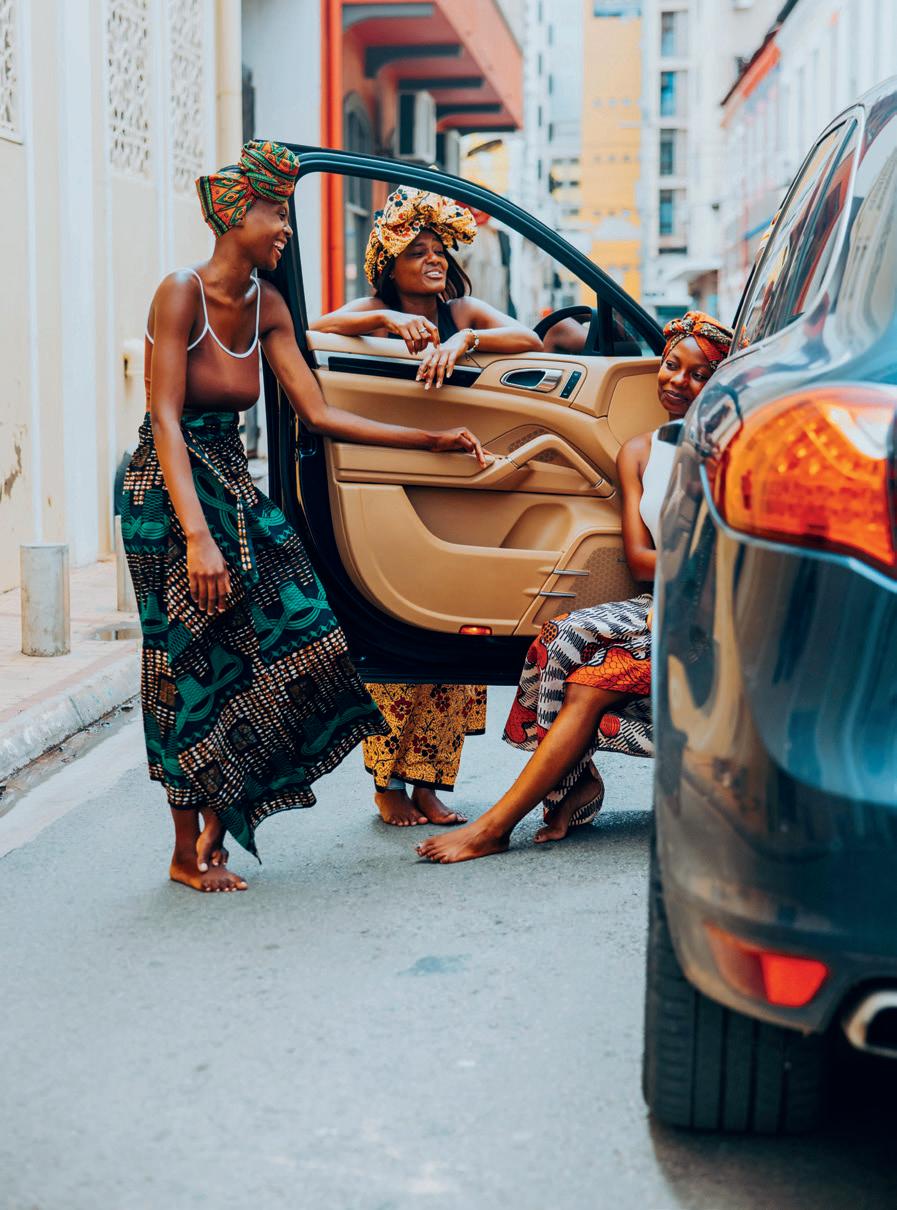
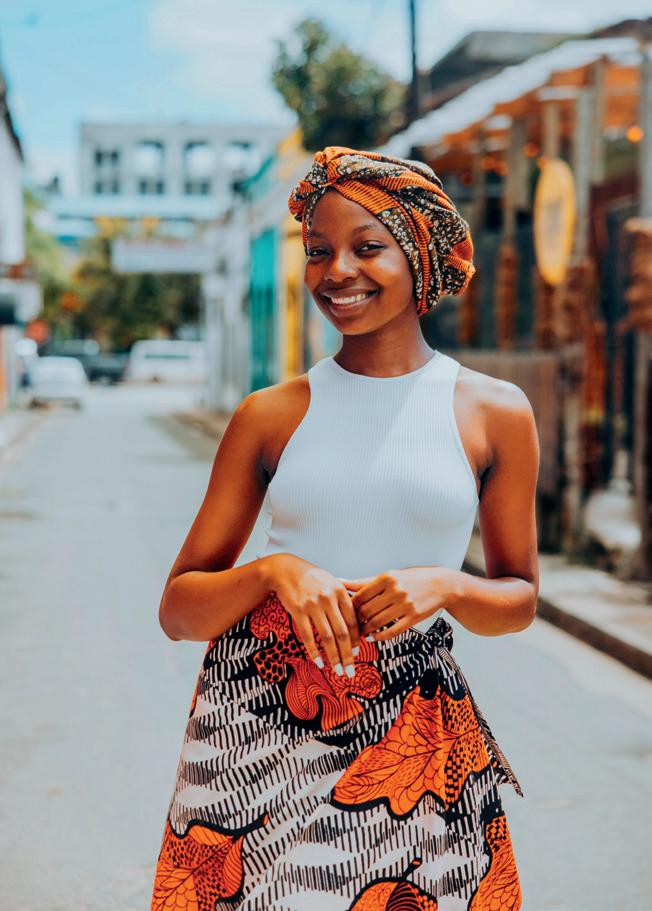

Handgemaakte ring in 18kt witgoud met witte diamanten en een prachtige peervormige aquamarijn. Exclusief ontwerp door Maarten Slaets.
NIEUWE LOCATIE LEYSSTRAAT 1, 2000 ANTWERPEN - 03/213 50 80 SCHUTTERSHOFSTRAAT 30, 2000 ANTWERPEN - 03/226 41 44

The impressive Estação Central dos Caminhos de Ferro , or Maputo Central Train Station, is another photogenic site. It was built between 1913 and 1916. Its architecture is striking, with an impressive green dome and wrought-iron details that strongly resemble the Parisian Eiffel Tower. This resemblance has led to the widespread belief that Gustave Eiffel designed the station, though there’s no solid evidence to support that. What is known is that the design was by Portuguese engineer José Ferreira da Costa, who was likely inspired by Eiffel. The station is still in use and connects Maputo with South Africa, Eswatini, and Zimbabwe. Today, however, there is no activity. Two trains stand motionless on the tracks, awaiting passengers who will not arrive. Public transport has been suspended due to the presidential inauguration. The station is often listed among the most beautiful in the world and has served as a filming location for various international productions.
architecture of the imposing Estação
Central dos Caminhos de Ferro is very reminiscent of the Parisian Eiffel Tower.





Our quest to find a Porsche owner in Mozambique cost us blood, sweat, and tears. We quickly realized that a simple piece of paper measuring 36 by 25 mm was no guarantee of finding a Porsche. Porsche has no dealership in Mozambique, so that avenue was closed. Moreover, there was no Porsche club in the country—an ominous sign that, if there were any Porsches at all, they would be very few. We didn’t give up, however, and turned our attention to garage owners in Maputo. There were many, making the search like finding a needle in a haystack. One of them had a Porsche listed on their website. Excited, we called. Had we finally found something? A friendly man answered but regretfully told us that the Porsche he serviced had been sent to South Africa. He promised to ask around with colleagues and keep us updated. And sure enough, two weeks later he called to say he had found a Porsche owner. That’s how we finally found our unicorn. Hussein Ibny Ali Hassan, owner of a 911 and the only Porsche driver in all of Mozambique. He was immediately intrigued by our story and was more than happy to participate in our report. Bingo!
Of course, we also wanted to learn more about the Porsche stamp that had set this whole trip in motion. Our first visit to the post office in Maputo turned up nothing. Nor did the second. But on the third attempt—third time’s the charm—we found someone willing to dig into the archives. He discovered that the stamp had been designed and printed in Lithuania by the printer Stamperija. Lithuania—of all places! How could that be? We contacted the printer and learned that Stamperija has for decades been a commercial publisher and printer of stamps. It holds exclusive contracts with many countries—often smaller or developing nations—and produces stamps on their behalf. Its clients include countries such as Sierra Leone, Djibouti, Togo, the Solomon Islands, Tuvalu, and... Mozambique. Most of the stamps printed by Stamperija are not intended for domestic use, but rather as collectibles for philatelists worldwide. That explains the choice of popular themes like celebrities, royalty, anniversaries, sports, animals, and so on. The Porsche stamp we found is one of those thematic stamps, designed and issued for the international collectors’ market on behalf of Mozambique Post to mark the 50th anniversary of the 911. For both parties, it’s a win-win. The printer earns revenue from stamp sales, and the client country receives a share of the profits without having to lift a finger. And so, we unexpectedly learned quite a bit about the world of philately.

The Mozambican Porsche stamp that started our journey was designed and issued for the international collectors' market to mark the 50th anniversary of the 911.
















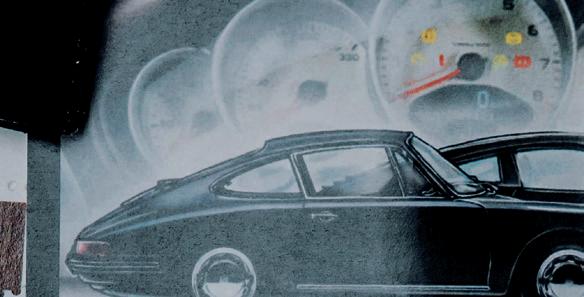



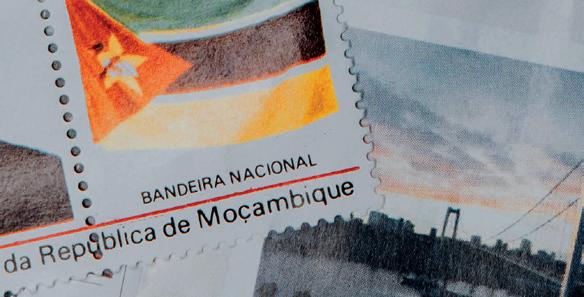
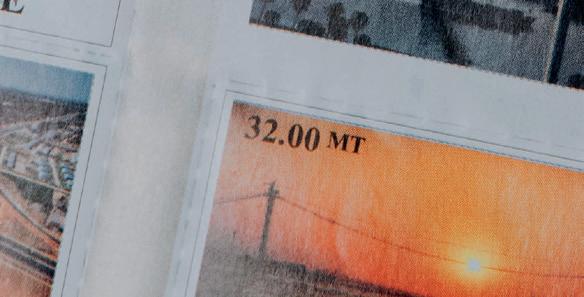

























We are invited by Mercia, a woman who spontaneously took part in the photoshoot in Maputo. She wants us to try a traditional Mozambican dish, commonly served in the southern part of the country and called cacana. She is already stirring pots when we arrive. She explains that the main ingredient in cacana is the leaves of the cassava plant (also known as manioc). Mercia cooks the leaves and adds ground peanuts, freshly grated coconut, coconut milk, and salt. At the same time, she prepares Xima. Xima is true staple food in Mozambique. Because it’s cheap yet nutritious, it’s indispensable in a country where many struggle to make ends meet. It’s a thick maize porridge, similar to polenta, and is served with nearly everything. Xima doesn’t have much flavor, which allows the cacana to shine. It’s absolutely delicious, and Mercia beams as we compliment her cooking.


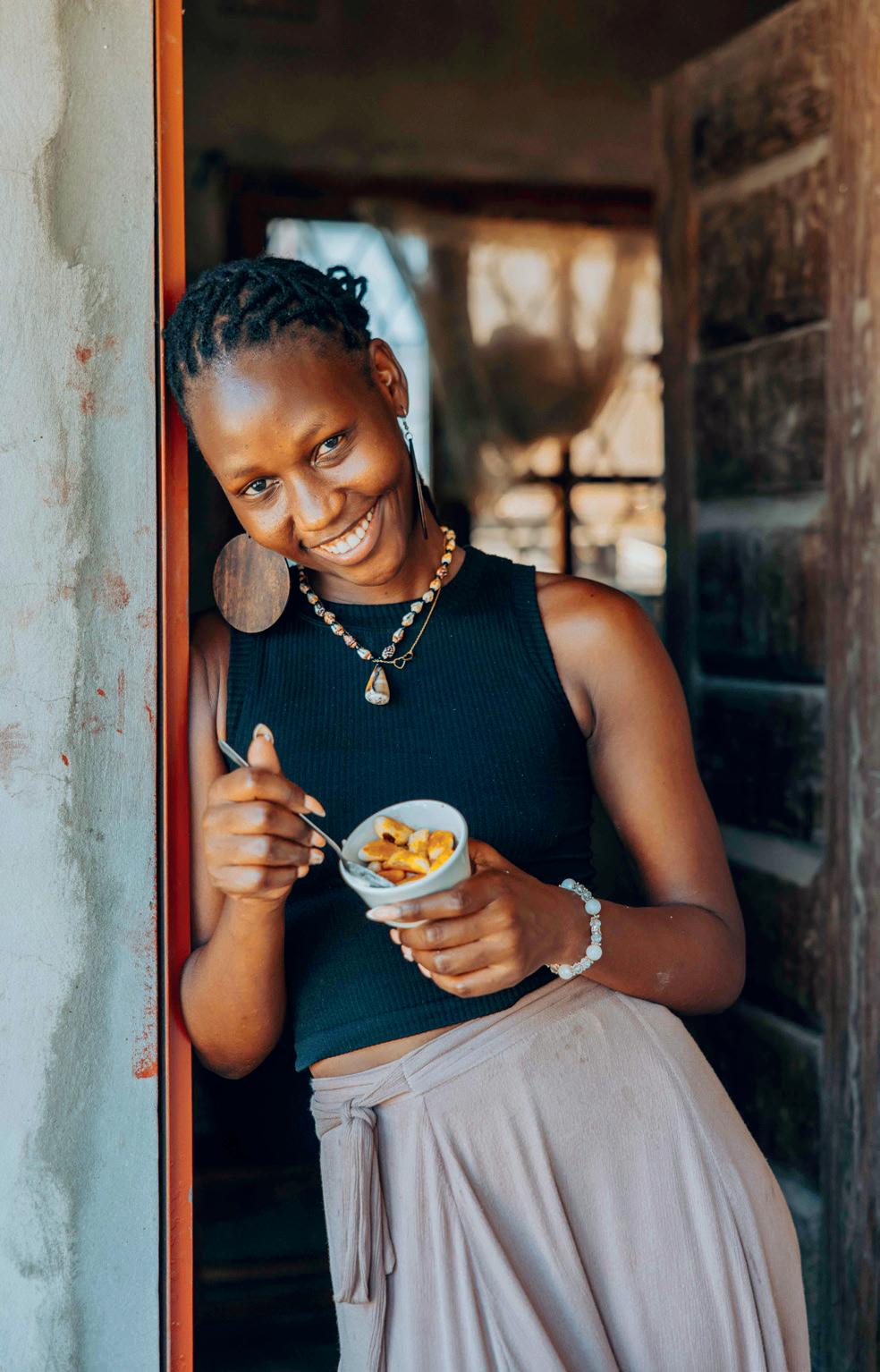




Having explored Maputo thoroughly, we drive to Maputo National Park , about two hours south of the capital. Because Mozambique is also safari. At the park entrance, a ranger greets us. He nods toward a pale track winding through the greenery. “Good luck,” he says — a wish always welcome when seeking wildlife. We drive slowly, windows down, ears perked. The first animals we see are impalas — graceful reddish-brown silhouettes that look up nervously and leap away in elegant arcs. A bit further, a group of warthogs crosses the road, their tails sticking straight up like antennae. A lone wildebeest stands still and lets itself be admired. The landscape is breathtaking. Open savannas alternate with dense forests and lakes filled with lilies. In the distance, the glistening water of Lake Maputo — the park’s largest lake — beckons. We decide to drive there. A herd of elephants heads in the same direction. The giants lumber peacefully through the grass, their massive bodies swaying side to side. A calf lingers and looks directly at us — curious but unafraid. Not yet afraid. It doesn’t know that humans are its greatest threat. Elephants are vitally important to the park.
During Mozambique’s civil war (1977–1992), many animals were killed, and the elephant population plummeted. This park launched a dedicated program to protect them, and it has paid off — the elephant numbers have grown significantly. Mozambicans often refer to the park as the Maputo Elephant Reserve . What’s more, it is home to a unique subspecies: the rare coastal elephant. These elephants are special because they live in forests and mangroves near the ocean — unusual for African elephants, which typically inhabit inland savannas or forests. These elephants love wading in the Indian Ocean.
By now it’s afternoon, and the light begins to soften. We continue toward the coast. Suddenly, the bush opens up and we are face to face with a view that takes our breath away: endless dunes roll like waves to the Indian Ocean. Here, two worlds meet — the wild savanna and the infinite sea. The ocean gleams bright blue, whitecaps dancing in the surf. In a nearby lagoon, a group of flamingos stands in the shallow water, their pink reflections mirrored on the surface. In the sand, we spot fresh turtle tracks — evidence they came ashore last night to lay eggs. What an incredible day and what an extraordinary experience.
In Maputo National Park, a programme was set up specifically to protect the ailing elephant population.





Machangulo Beach Lodge is beautifully situated on the pristine peninsula between Maputo Bay and the Indian Ocean.

As the sun sets and the sky erupts in fire and gold, we head to our accommodation for the night. Machangulo Beach Lodge is beautifully located on the untouched Machangulo Peninsula, nestled between Maputo Bay and the Indian Ocean. The peninsula is a mix of forests, dunes, and silky white beaches. A winding wooden walkway leads us to the lodge’s main building, which houses a spacious lounge, bar, and restaurant. Lower down are a beach bar, a swimming pool with a sun terrace, and a spa. Hidden on a dune ridge are nine luxurious thatched-roof chalets, each offering a breathtaking view of the ocean and nearby Inhaca Island. This is a dream destination—a beach paradise not yet discovered by mass tourism. In addition to soaking in the scenery, there are plenty of activities. The crystal-clear water and colorful coral reefs are perfect for snorkeling and diving, but canoeing, paddleboarding, and fishing are also popular. You can swim on both sides of the peninsula—either in the open sea or the calm lagoon.
We opt for a trip on a traditional dhow, a wooden sailboat with a distinctive triangular sail. The sky is clear blue, the breeze gentle, and the water beneath us a fairytale mosaic of turquoise and deep blue. The sail, striped in green, yellow, and orange, catches the wind and billows like a pregnant belly. Around us, a blissful calm reigns—only the soft lapping of water and the distant cries of seabirds break the silence. For a moment, time seems to stand still.

We said few people know about Machangulo, but one who does is King Willem-Alexander of the Netherlands. He was so enchanted by the area that he built a vacation home here in 2007. It was meant to be a private retreat for him and his wife Máxima, far from the public eye, to enjoy the stunning nature and beaches in peace. But things turned out differently. The media and political backlash in the Netherlands was so intense that Willem-Alexander and Máxima had no choice but to sell the house—before they even had a chance to use it. Today, the villa—fittingly named “The Monarch”—can be rented as a luxury stay, though at a very regal price.


The beautiful @Beyond Benguerra Island Lodge has just 15 casinhas tucked among dunes and palm trees with the beach literally at your feet.


Once in a great while, you come to a place so beautiful and untouched you can hardly believe it’s real. Benguerra Island is one of those places—a slice of pure magic hidden in the azure waters of the Bazaruto Archipelago. Off the coast of Mozambique lie many islands, but Benguerra stands out for its beauty. The only way to reach it is by helicopter, offering a full aerial view of coral reefs, powder-white beaches, and crystal-clear waters. To complete the fairytale, we stay at the stunning @Beyond Benguerra Island Lodge Fifteen villas—casinhas, as they’re called—are tucked among the dunes and palm trees, with the beach right at your doorstep. Each evening, we watch the sun sink into the sea in a fiery blaze, and each morning we wake to the gentle sound of waves and a dawn that bathes the island in golden light. Everything here exudes peace and unspoiled beauty. Our days fill effortlessly with unforgettable moments—including a horseback ride through the surf. Here, our minds completely unwind. Benguerra stays with you—and honestly, we wouldn’t have it any other way.


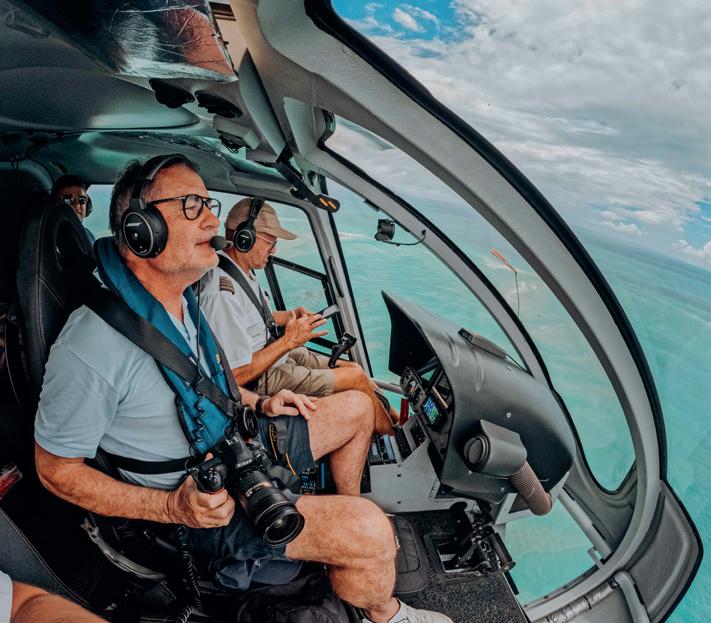





On Benguerra Island, the sea is the beating heart of the local community. Early in the morning, traditional wooden dhows glide across the water, propelled by wind and the skilled hands of fishermen following rhythms passed down through generations. Using simple nets and lines, they catch whatever the ocean offers that day—colorful fish, squid, sometimes lobster. The catch is traded right at the water’s edge, where islanders gather to buy, barter, and share stories. It’s a lively and authentic scene that brings us back to a time when humanity lived in harmony with nature. The hospitality of the islanders is heartwarming and sincere. Everywhere we go, we’re welcomed with open arms. In a world where kindness too often turns into commercial opportunism, it’s refreshing to experience a community that still values honesty, mutual respect, and genuine appreciation.



Early in the morning, traditional wooden dhows glide across the water, propelled by the wind and the experienced hands of fishermen who have followed the same rhythm for generations.

MOZAMBIQUE: UNEXPECTED AND UNFORGETTABLE
Mozambique has surprised us in every possible way—from the wild beauty of its national parks to the pristine islands, from lively villages to the warm hospitality of its people. We leave with memories that will linger for a long, long time.
Special thanks to :
- Vera Van Steenvoort, www.advalorem.be
- Ethiopian Airlines, Mr. Solomon Endale
- Maureen Okore, Regional Marketing Director Serena Hotels, www.serenahotels.com
- Nelson Rodrigues, GM Polana Serena Hotel
- Machangulo Beach Lodge
- &Beyond Benguerra Island Lodge
- Simba Munyambo, local guide
- Hussein Ibny Ali Hassan, Porsche owner
- Graatje Weber, video producer & photographer, Eyecandy-media.com
the tourbillon is one of the most sophisticated complications in fine watchmaking. the balance wheel and pallet lever are placed inside a small cage that rotates around its axis once every minute. this constant rotation contributes to offsetting the effect of gravity on the oscillating system of the watch, thereby increasing its accuracy. its complexity also makes the tourbillon a highly delicate and fragile mechanism. as dozens of parts have to work together in a confined space, it is particularly vulnerable to damage by shocks. with the big pilot’s watch shock absorber tourbillon skeleton xpl (ref. iw357701), iwc engineering division xpl has now pushed the boundaries in fine watchmaking again. marking a first for the brand, this highly complex watch combines the patented spring-g protect shock absorber system with a tourbillon.



"The Polana Serena Hotel is a destination in itself."
An interview with General Manager Nelson Rodrigues.
n the terrace of one of Africa’s most iconic hotels, we meet Nelson Rodrigues. In front of the entrance, armored Mercedes cars gleam in the sun and heavily armed security guards stand watch: thirteen heads of state are staying at the hotel for the inauguration of Mozambique’s new president. Amid this diplomatic whirlwind, Nelson calmly and resolutely runs the historic five-star hotel.
Text: Kathleen Van Bremdt - Photos: Sven Hoyaux

Who is Nelson Rodrigues?
I was born in Mozambique just before independence but grew up in South Africa. My parents are Portuguese. I’ve had a passion for hospitality since I was eighteen. It’s what drives me—it’s why I get out of bed every morning.
You haven’t been in Maputo very long.
Just three months. I arrived on October 9th, 2024, right before the elections. It's a great honor to be entrusted with the management of this iconic hotel. Things moved fast from the start, as the political climate became quite tense following the elections, presenting a number of challenges.
Tell us about the hotel.
The Polana Serena Hotel is truly a landmark. It’s rightly called the “Grande Dame of Africa.” The hotel is over a hundred years old and has a very rich history. Over the years, many kings, presidents, and celebrities have stayed here. The hotel was designed so that all 153 rooms have a sea view. There are very few hotels in the world that can claim that. This hotel is without a doubt the crown jewel of the Indian Ocean. It is a destination in itself.
“No day is ever the same. There are always new challenges. But that’s exactly what drives me.”
Nelson Rodrigues
Who owns the building?
The government does. We have a 50-year lease. That makes things interesting—it’s partly their “playground,” but also our showpiece.
The past few months have been turbulent in Mozambique. How do you manage a hotel during such a difficult time with riots and blockades?
The post-election period was indeed intense. In a way, I was fortunate to come from South Africa, where I’ve experienced similar situations. We were determined to keep the hotel open. There are 320 employees here. Their salaries and safety were top priorities. To keep the hotel running, good planning and preparation were crucial. We purchased a Starlink installation to maintain a stable internet connection. We anticipated supply chain disruptions and shortages of food, water, and fuel, so we stocked up heavily. Mozambique is quite isolated. Almost all goods have to be imported from South Africa or Sub-Saharan Africa. Some trucks were stopped at the border and port operations in Maputo were disrupted, so we looked for alternative routes through tourist areas like Ponta do Ouro. Those areas depend on tourism and were unaffected by the unrest. You need to be creative and always have backup options—a plan B, C, and D.
What’s it like to host 13 heads of state at the same time?
Quite a challenge! Each guest has their own preferences, security protocols, and sensitivities. With such highprofile guests, it’s always a bit of a balancing act. Leaders of countries who don’t get along should preferably not run into each other in the hotel. We accommodate them in different wings. Even breakfast is scheduled strategically. There’s a lot of behind-the-scenes coordination to ensure everything runs smoothly. But that’s exactly what drives people in hospitality. No day is ever the same. There are always new challenges.
Why should our readers visit Mozambique?
Because it has everything: endless beaches, wildlife parks, and a warm, friendly population. Here you can go on a safari in search of the Big Five and lie on the beach on the same day. That’s a huge asset. In both the north and the south of the country, there are stunning archipelagos with idyllic resorts. The country is also historically fascinating. It’s one of the few former colonies that has preserved part of its European identity. You can see it in the language and taste it in the delicious cuisine. And prices are fair. If you travel to Mozambique, you truly get value for your money.
What kind of tourists visit most often?
South Africans are the largest group. From Europe, we mainly receive Portuguese, French, and surprisingly many Scandinavians. We also host many cruises, especially from MSC.
You’ve had an impressive international career. How did it start?
As a sommelier on cruise ships. I’m a huge wine enthusiast. In the 1990s, I got an opportunity through connections to apply in the UK. A few weeks later, I was aboard a ship departing from Southampton. That’s how I got to see almost the whole world. My son often asks me if I’ve been to certain countries or cities, and my answer is always: If it has a sea and a port, probably yes. After my time on cruise ships, I became general manager of a series of top-tier hotels in South Africa, until I landed here at the Polana Serena Hotel. No complaints from me. ♦
Best of luck in your new role, Nelson.
“I consider it a great honor to manage this iconic hotel.” Nelson Rodrigues




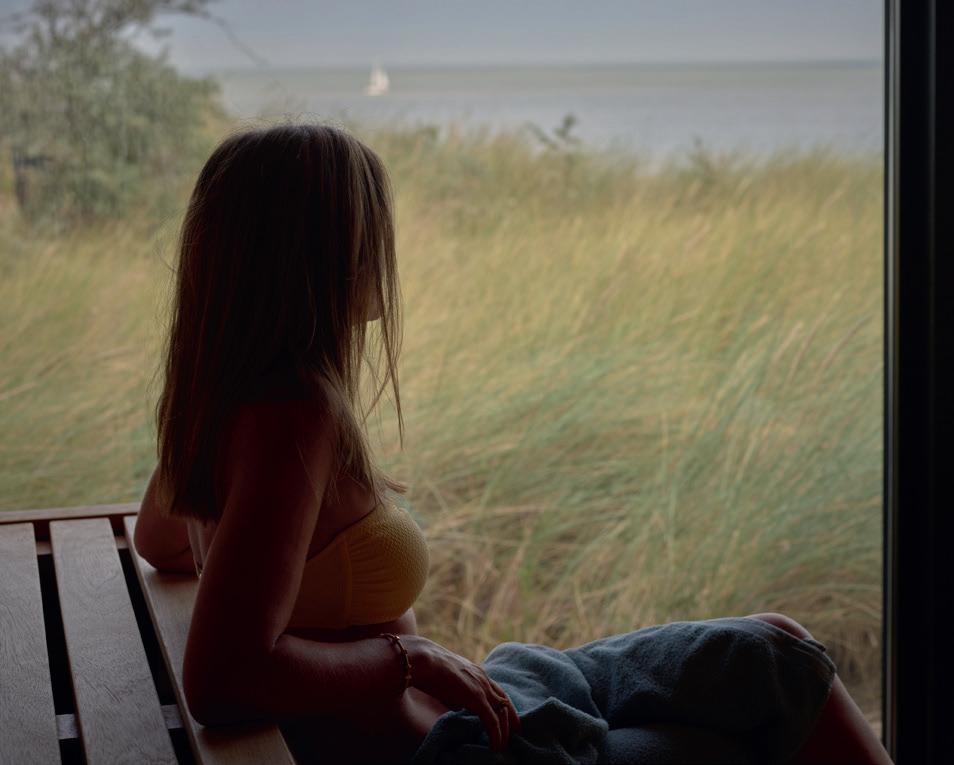

here is only one Porsche in circulation in all of Mozambique, and it is registered in the name of Hussein Hassan (37). It took quite a bit of detective work to track him down, but here he is — ready to answer our questions.
Text: Kathleen Van Bremdt - Photos: Sven Hoyaux
Who is Hussein Hassan?
I was born in Mozambique but grew up in Portugal. I live in Maputo, I'm married, and I have two children. When I was young, I wanted to become a professional football player. If that had worked out, I could already be retired by now. (laughs) I was good with a ball and had a decent amount of talent, but eventually I had to admit that a football career wasn't in the cards for me, and that it wouldn’t be my legs but my brain that would carry me through life. I went to university and earned a Master's degree in Tourism.
At the same time, I spent quite a bit of time in the nightlife and entertainment scene. I loved music and dancing and worked in events as an MC and DJ. I've always had a wide range of interests. For instance, I’ve also been fascinated by technology and even built my own computer back in the early 2000’s. All these different worlds have influenced me and shaped who I am today. I've met—and continue to meet—people from all sorts of backgrounds and professions. That’s enriching. I learn a lot from them.
“My introduction to Porsche led me to really dive into the brand.” Hussein Ibny Ali Hassan
How did you end up with a Porsche?
My love for Porsche came from my stepfather, with whom I have a very strong bond. The Porsche I currently drive—the dark blue Cayenne S—is actually his. He bought it in 2018, later passed it on to my mother, and then bought a white Cayenne Turbo GT for himself. When my mother said she wanted to sell the car because she wasn't using it enough, I seized the opportunity and made an offer. Of course, my parents agreed.
The interesting thing is that, until shortly before that, I wasn’t into Porsche at all. I was actually a BMW fan.
What changed your mind?
The moment I drove the Cayenne, I was hooked. It completely won me over. Porsche has managed to create sports cars with an unmatched look and feel without compromising on comfort. That first experience with a Porsche made me dive deep into the brand. I learned about Porsche’s rich history, its iconic models, and the many technological innovations that have kept it at the forefront of the industry.
I also find Porsche’s role in motorsport fascinating. The brand has had a lot of success in major competitions like the 24 Hours of Le Mans. Now, it’s my dream to someday drive a racing cup car—and if I ever get that chance, I want it to be in a Porsche GT3 RS. That’s the ultimate machine. I’d also love to visit the factory in Stuttgart. That’s right at the top of my bucket list.
What makes the Cayenne so special to you?
For me, Porsche isn’t a status symbol or a measure of success. The car simply marks the stage I’m at in life and what I’ve achieved so far. Even though I’m only 37, I can see how much I’ve grown in recent years, and that makes me feel good.
Is the Cayenne suitable for Mozambique?
Absolutely. The Cayenne is an exceptionally well-built SUV. It has a powerful character and strong performance. I’m pleasantly surprised by how well it performs here in Mozambique, where roads are often in poor condition and the hot, humid climate ruins many cars. But the Cayenne can handle it all and drives like a dream.
It even made it through the recent flooding, as you mentioned. Flooding is a regular occurrence in Mozambique. You obviously try to avoid waterlogged roads, but a few weeks ago I found myself right in the middle of one. The water reached the bottom edge of my doors. I expected all kinds of warning lights to go off on the dashboard, but nothing happened. The Cayenne got me home safely like it was nothing.

The Cayenne already has quite a few kilometers on it. Do you plan to keep driving it for a while?
It’s got 260,000 kilometers on the clock—that’s quite a bit—but I don’t notice it at all. The car still looks almost brand new. I believe this Porsche can go for just as many kilometers again, as long as I take good care of it.
There’s no Porsche dealer in Mozambique. How do you maintain the car?
I take my Porsche to South Africa. Good maintenance ensures that the Cayenne retains its value, so I find it very important that the service is done under the best possible conditions. There are no Porsche agents or capable garages in Mozambique to fix these kind of premium cars. Plus, I enjoy those long drives. The distance between Maputo and Johannesburg is about 600 kilometers. It’s doable.
How safe is Mozambique? The Belgian Foreign Affairs website has issued a negative travel advisory.
There’s very little crime in Mozambique. After the recent elections, there were some street protests and demonstrations, but that period of unrest is over. The real problem is the media. They blow everything out of proportion. There weren’t millions of people on the streets, as was reported. You’re here—do you feel unsafe? I don’t think so. Every country has its problems, and Mozambique has its own to deal with.
“The Cayenne marks the stage I’m at in life and what I’ve achieved so far.”
Hussein Ibny Ali Hassan
What are the biggest issues in Mozambique right now?
Mozambique is still a developing country, and you notice that in many areas. Our infrastructure is a disaster—we urgently need better roads. Basic utilities like water and electricity need to be expanded and improved so that everyone has access.
We must invest in education and training, but with a focus on what Mozambique actually needs. It makes no sense to copy other countries. Every nation has its own challenges. We need to bring Mozambique to the forefront, and that can only happen if we’re allowed to take the lead. Put power in the hands of local entrepreneurs and let us collaborate with policymakers to move Mozambique forward. I truly believe in this country. It’s a fantastic place with kind, humble people. All we need is good leadership.
Do you think the new president, Daniel Chapo, will provide the leadership you’re hoping for?
He’s only just taken office, so it’s too early to say. But in his inauguration speech, he said a lot of hopeful things. Honestly, things couldn’t get much worse. The previous president, Filipe Nyusi, didn’t do a good job on any front.
Do you feel that you personally contribute to Mozambique’s growth?
Yes, in a small way—by creating jobs. I have my own business and run two petrol stations about 35 kilometers from the South African border with Mozambique. There are other stations, but ours are the biggest. One is for cars and the other is exclusively for trucks. Before, there was nothing there.
My parents started the project and now it’s a family run business, with me and my brother joining them to help develop into the big business it is today. Now there’s also a restaurant and a store. We have a parking area where truck drivers can spend the night, with showers and restrooms. Truckers can come to us with any questions. We help them fill out licenses, customs forms, and toll road permits.
What does Mozambique have to offer tourists?
Our beautiful beaches are our biggest asset—absolutely unbeatable. If you love nature and wildlife, our national parks are a must. The Gorongosa National Park in the center of the country is highly recommended. I also think the many small villages are worth visiting. Life there is simple but very authentic. And you’ll find great restaurants everywhere. Our seafood dishes couldn’t be any fresher. ♦
We can definitely confirm that. Thanks for the interview.

